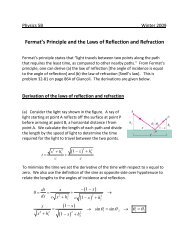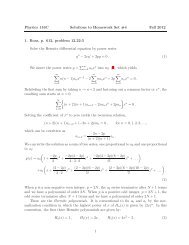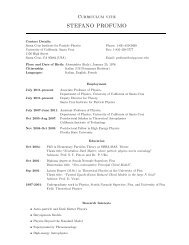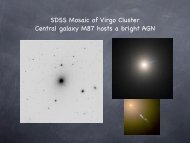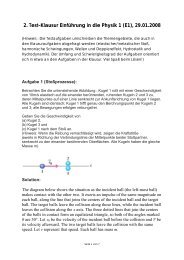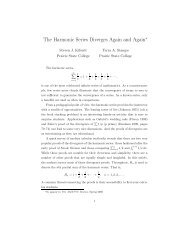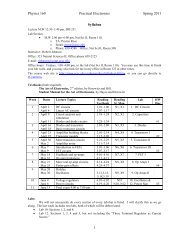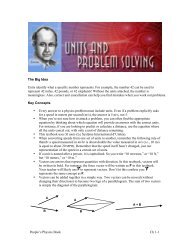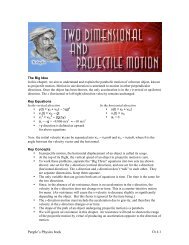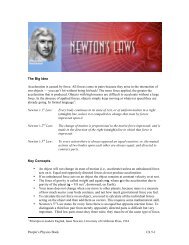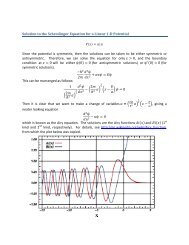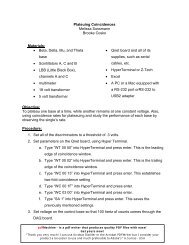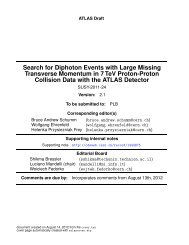Compound Optics Prelab - SCIPP
Compound Optics Prelab - SCIPP
Compound Optics Prelab - SCIPP
You also want an ePaper? Increase the reach of your titles
YUMPU automatically turns print PDFs into web optimized ePapers that Google loves.
<strong>Compound</strong> <strong>Optics</strong> <strong>Prelab</strong><br />
1 Astronomical Telescope<br />
An astronomical telescope, intended for visual observation, is constructed with an objective<br />
lens with focal length f 1 = +150 mm and an eyepiece lens with focal length f 2 = +75 mm.<br />
The telescope is used for viewing distant objects (s 1 >> f 1 ). Make a scale drawing of the<br />
telescope, showing the position of the intermediate image. What is the magnification of<br />
the telescope?<br />
The astronomical telescope is a system consisting of two lenses. The way to make calculations is to<br />
divide this system into two smaller subsystems, each consisting of one lens.<br />
The first system consists of the object, the objective lens, and the intermediate image, which is the<br />
image produced by the objective lens. The object is at a distance s 1 from the objective lens. The objective<br />
lens has focal length f 1 . The distance between the objective lens and the (real) intermediate image<br />
is s ′ 1. (Since the intermediate image is real, do you expect it to be on the same side of the objective lens<br />
as the object, or do you expect it to be on the other side of the lens?)<br />
The second system consists of the intermediate image, which acts as the object for the eyepiece lens, the<br />
eyepiece lens, and the final image, viewed by the human eye. The distance between the intermediate<br />
image and the eyepiece lens is s 2 . The focal length of the eyepiece lens is f 2 . The distance between the<br />
eyepiece lens and the (virtual) final image is s ′ 2.<br />
If you look at the diagram of the telescope in your lab manual, you will see that the total distance<br />
between the objective lens and the eyepiece lens is the distance from the objective lens to the intermediate<br />
image plus the distance from the intermediate image to the eyepiece lens. In other words,<br />
D = s ′ 1 + s 2 .<br />
In order to make a scale drawing of the telescope, we need to find the two distances s ′ 1 and s 2 .<br />
order to find these two distances, we will have to make some assumptions about s 1 and s ′ 2.<br />
In<br />
1.1 Intermediate Image<br />
The focal length of the objective lens is f 1 . We know that<br />
f 1 = 150 mm<br />
Let s 1 be the distance between the object and the objective lens. We are told that the telescope is<br />
used to view distant objects. This means that the distance s 1 is very, very large,<br />
s 1 → ∞<br />
Define the distance from the objective lens to the intermediate image to be s ′ 1. We need to find s ′ 1.<br />
Since we know the focal length f 1 and the distance s 1 , we can use the lens equation to find s ′ 1. The lens<br />
equation is<br />
1<br />
+ 1 s 1 s ′ = 1<br />
1 f 1<br />
1
So<br />
1<br />
s ′ 1<br />
= 1 f 1<br />
− 1 s 1<br />
We have made an assumption about the object distance s 1 . Use this assumption to calculate the<br />
inverse of the object distance,<br />
Remember from your calculus class that<br />
lim<br />
x→∞<br />
1<br />
s 1<br />
1<br />
x → 0<br />
The lens equation should simplify to include just two terms. Now it is easy to take the inverse of the<br />
lens equation.<br />
What is the distance s ′ 1 from the object lens to the intermediate image in millimeters?<br />
1.2 Final Image<br />
“The astronomical telescope is intended for visual observation.” What does this statement<br />
mean?<br />
The first assumption which you should make is that your eye is as close to the eyepiece lens as possible.<br />
For the sake of convenience, define the distance between the eye and the eyepiece lens to be zero.<br />
The second assumption which you should make is that the magnitude of the distance between the<br />
eye and the intermediate image is extremely large. (In this case we say that the eye is “relaxed”.)<br />
Since your eye is very close to the eyepiece lens, the magnitude of the distance s ′ 2 between the eyepiece<br />
lens and the final image is also extremely large,<br />
|s ′ 2| → ∞<br />
(The final image is virtual, so the image distance s ′ 2 is negative.)<br />
The lens equation is<br />
Consider what<br />
implies about the term<br />
1<br />
+ 1 s 2 s ′ = 1<br />
2 f 2<br />
|s ′ 2| → ∞<br />
1<br />
s ′ 2<br />
The lens equation should once again simplify to contain two terms. Take the inverse of these two<br />
terms. What is the distance s 2 from the intermediate image to the eyepiece lens, as a multiple of the<br />
focal length f 2 ?<br />
2
1.3 Drawing<br />
You now know enough to make a very accurate diagram of the telescope. Your drawing does not need<br />
to be a principal ray diagram, because it is difficult to include objects and images which are at infinity<br />
in a ray diagram. However,the finite distances depicted in your drawing must be to scale, and it must be<br />
drawn with a ruler.<br />
Start with the “distant object” on the left. The distance from object to objective lens is s 1 . The<br />
distance from the objective lens to the intermediate image is s ′ 1. Indicate the focal length f 1 of the<br />
objective lens in your diagram.<br />
You calculated the distance s 2 from the intermediate image to the eyepiece lens.<br />
length f 2 of the eyepiece lens in the diagram.<br />
Include the focal<br />
You also know the distance s ′ 2 between the final image and the eyepiece lens. Note that the final<br />
image is virtual. Will it be on the same side of the eyepiece lens as the intermediate image, or will it<br />
be on the opposite side of the lens? Remember that we are assuming the eye is positioned very close to<br />
the eyepiece lens, and the image needs to be in front of the eye.<br />
1.4 Magnification<br />
The magnification provided by the objective lens is<br />
( ) s<br />
′<br />
M 1 = − 1<br />
s 1<br />
The magnification provided by the eyepiece lens is<br />
( ) s<br />
′<br />
M 2 = − 2<br />
s 2<br />
The total magnification is the product of these two quantities,<br />
M = M 1 · M 2<br />
( ) ( )<br />
s<br />
′<br />
M = 1 s<br />
′<br />
· 2<br />
s 1 s 2<br />
Note that s 1 → ∞ because we are viewing a distant object, and s ′ 2 → −∞ because the final image<br />
is virtual and the eye is relaxed. So we can say that s 1 ≈ −s ′ 2 and simplify the expression for the<br />
magnification,<br />
( ) s<br />
′<br />
M ≈ − 1<br />
s 2<br />
You calculated the distance s ′ 1 of the intermediate image as a multiple of the focal length f 1 of the<br />
objective lens. You calculated the object distance s 2 as a multiple of the the focal length f 2 of the<br />
eyepiece lens. If you insert these quantities into the above expression for the magnification, you should<br />
obtain equation 33 in your lab manual.<br />
2 Optical Microscope<br />
An optical microscope is intended for visual observation. The objective lens has a focal<br />
length f 1 = +75 mm. The eyepiece lens has a focal length f 2 = +150 mm. The microscope is<br />
used for viewing an object at a distance of 125 mm from the objective lens. Determine the<br />
position of the intermediate image, and make a scale drawing of the microscope, showing<br />
3
the position of the intermediate image. Calculate the optimum magnification of the microscope.<br />
Like the telescope, the microscope is a system consisting of two lenses.<br />
this system into two smaller subsystems, each consisting of one lens.<br />
Once again we will divide<br />
The first system consists of the object, the objective lens, and the intermediate image. The object<br />
is at a distance s 1 = 125 mm from the objective lens. The objective lens has focal length f 1 . The distance<br />
between the objective lens and the (real) intermediate image is s ′ 1.<br />
The second system consists of the intermediate image, which acts as the object for the eyepiece lens, the<br />
eyepiece lens, and the final image, viewed by the human eye. The distance between the intermediate<br />
image and the eyepiece lens is s 2 . The focal length of the eyepiece lens is f 2 . The distance between the<br />
eyepiece lens and the (virtual) final image is s ′ 2.<br />
We need to find the two distances s ′ 1 and s 2 .<br />
make some assumptions about s 1 and s ′ 2.<br />
In order to find these two distances, we will have to<br />
2.1 Intermediate Image<br />
Determine the position of the intermediate image.<br />
The focal length of the objective lens to be f 1 . The problem states that<br />
f 1 = 75 mm<br />
Define the distance between the object which is being viewed and the objective lens to be s 1 . The<br />
problem states that the object is at a distance of 125 mm from the objective lens, so<br />
s 1 = 125 mm<br />
Define the distance between the objective lens and the intermediate image to be s ′ 1. You need<br />
to find s ′ 1.<br />
The lens equation relates the focal length of the lens to the distances between the object, the image,<br />
and the lens,<br />
1<br />
+ 1 s 1 s ′ = 1<br />
1 f 1<br />
Since you know the focal length f 1 and the distance s 1 , you can find the distance s ′ 1,<br />
1<br />
s ′ 1<br />
= 1 f 1<br />
− 1 s 1<br />
s ′ 1<br />
1 = ( )<br />
1<br />
f 1<br />
− 1 s 1<br />
How far (in millimeters) is the intermediate image from the objective lens?<br />
Is this distance positive? In other words, is this a real image?<br />
Calculate the magnification M 1 ,<br />
( ) s<br />
′<br />
M 1 = − 1<br />
s 1<br />
Is the intermediate image magnified? What does the negative sign mean?<br />
4
2.2 Final Image<br />
“The microscope is intended for visual observation.” In figure 14 your lab manual says “the<br />
optimum configuration is for |s ′ 2| ≈ 250 mm”. What does this mean?<br />
If you have ever used a microscope, you will remember that you had to lean down until your eye was<br />
very close to the eyepiece lens. The shortest allowed distance between the eye (and thus the eyepiece<br />
lens) and the final image is 250 mm. (If the image is any closer than this, a human eye cannot focus on<br />
it.) In order to obtain the best possible magnification, the final image must be at exactly this position.<br />
For this reason, we define the image distance<br />
|s ′ 2| = 250 mm<br />
Since the final image is virtual, s ′ 2 will be negative.<br />
Define f 2 to be the focal length of the eyepiece lens. We know that the focal length of the eyepiece<br />
lens is<br />
f 2 = 150 mm<br />
The intermediate image is the image which was produced by the object lens. This image serves<br />
as the object for the eyepiece lens.<br />
Define the distance between the intermediate image and the eyepiece lens to be s 2 .<br />
to find s 2 .<br />
We need<br />
Use the lens equation to solve for the distance s 2 between the intermediate image and the eyepiece<br />
lens,<br />
1<br />
+ 1 s 2 s ′ = 1<br />
2 f 2<br />
What is s 2 ?<br />
1<br />
s 2<br />
= 1 f 2<br />
− 1 s ′ 2<br />
How much is the final image magnified with respect to the intermediate image?<br />
( ) s<br />
′<br />
M 2 = − 2<br />
s 2<br />
Is the final image inverted with respect to the intermediate image?<br />
2.3 Magnification<br />
We know that the intermediate image is magnified by a factor of M 1 with respect to the object.<br />
The final image is magnified by a factor of M 2 with respect to the intermediate image. The total<br />
magnification M is just the product of these two intermediate steps,<br />
M = M 1 · M 2<br />
M 1 is negative, since the objective lens produces a real, inverted intermediate image. M 2 is positive,<br />
since the eyepiece lens produces a virtual final image which is upright with respect to the intermediate<br />
image. The total magnification M is therefore negative, and the final image is inverted with respect to<br />
the original object.<br />
(Alternatively, you could have used equation 36 in your lab manual to calculate the total magnification<br />
M.)<br />
5
2.4 Drawing<br />
You now know enough to make a very accurate principal ray diagram of the microscope. Your ray<br />
diagram must be to scale and it must be drawn with a ruler.<br />
Start with the object on the left hand side. The distance between the object and the objective lens<br />
is s 1 . Include the focal length f 1 of the objective lens. Draw two or three rays as shown in your textbook<br />
(figure 31.17).<br />
Use your ray diagram to predict the image distance s ′ 1 of the intermediate image.<br />
with your calculation? Is the intermediate image real and inverted?<br />
Does this agree<br />
You calculated the distance s 2 between the intermediate image and the eyepiece lens. Include the<br />
focal length f 2 of the eyepiece lens. Draw two or three rays, and use your ray diagram to predict the<br />
position s ′ 2 of the virtual final image.<br />
Don’t be surprised if the final image is between the objective lens and the intermediate image.<br />
Does the distance s ′ 2 agree with our initial definition of this distance as being the closest position where<br />
the human eye can still focus?<br />
Is the final image virtual? Is the final image in your diagram M times the size of the initial object?<br />
You will need your diagram during the lab.<br />
6




